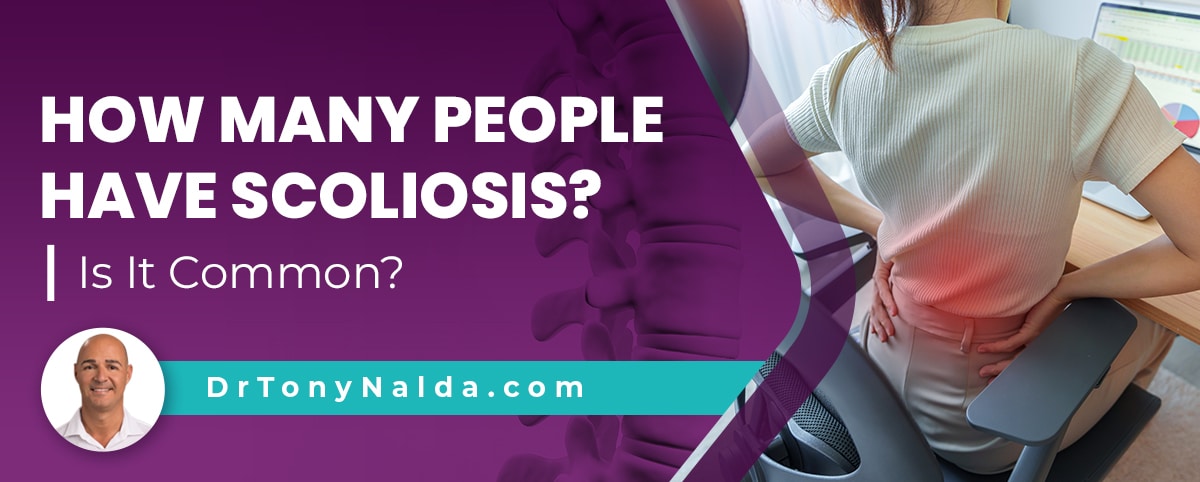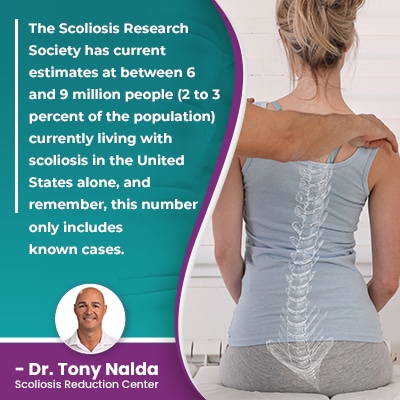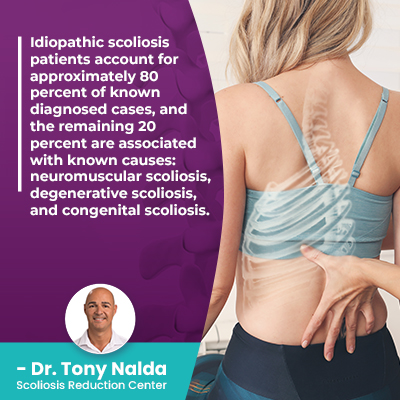How Many People Have Scoliosis? Is It Common?

There are a number of spinal conditions that involve a loss of its healthy curves, so in order to reach a diagnosis of scoliosis, certain condition characteristics have to be in place. Continue reading to find out how common scoliosis is, the different types, and age groups affected.
Scoliosis is a highly-prevalent spinal condition with current estimates at close to seven million people living with scoliosis in the United States alone. It is also the leading spinal condition amongst school-aged children.
Table of Contents
How is Scoliosis Diagnosed?
Scoliosis is diagnosed through a comprehensive physical examination, including a scoliosis X-ray so I can see what's happening in and around the spine.
Scoliosis involves the development of an unnatural spinal curve, with rotation, making it a 3-dimensional spinal condition.
In addition, a scoliotic curve has to have a minimum Cobb angle measurement of at least 10 degrees, and a patient's Cobb angle is determined during X-ray, tells me how are out of alignment a scoliotic spine is, and classifies conditions in terms of severity:
- Mild scoliosis: Cobb angle measurement of between 10 and 25 degrees
- Moderate scoliosis: Cobb angle measurement of between 25 and 40 degrees
- Severe scoliosis: Cobb angle measurement of 40+ degrees
- Very-severe scoliosis: Cobb angle measurement of 80+ degrees
The more severe a condition, the more noticeable its effects are likely to be.
Part of diagnosing scoliosis involves further classifying conditions based on important patient/condition characteristics, including patient age, condition type, curvature location, and condition severity.
Scoliosis is Progressive
The important thing to understand about the nature of scoliosis is that it's progressive, meaning that its nature is to worsen over time, so where a scoliosis is at the time of diagnosis isn't indicative of where it will stay; only proactive treatment options can work towards counteracting the condition's progressive nature.
The progressive line is the same as the condition's severity levels: mild to moderate and severe to very severe.
In cases of mild scoliosis, and particularly in young patients diagnosed with scoliosis, the condition's not known to be overly painful, cause functional deficits, and even the postural changes common in children scoliosis can be subtle at this level and difficult for anyone, other than a trained specialist, to notice.
This is why, despite the many benefits of early detection and intervention, it's not always easy to achieve, and that is also why, known numbers of people living with scoliosis are only estimates because the reality is there are also many people living with scoliosis unaware.
In fact, in adult scoliosis, the most common form is idiopathic scoliosis which doesn't develop fresh in adulthood with no prior history; cases of adults with idiopathic scoliosis are cases of adolescent idiopathic scoliosis that went undiagnosed and untreated during adolescence, and this is a common scenario.
Scoliosis doesn't become a compressive condition until skeletal maturity has been reached, and then the spine and its surrounding muscles and nerves are vulnerable to the condition's uneven forces and becomes painful.
No one wants to experience pain, but it does serve a vital role: it tells us something is wrong inside the body and can lead to a diagnosis and treatment.
Scoliosis Affects All Ages
Scoliosis affects all ages from congenital scoliosis to infantile idiopathic scoliosis to juvenile idiopathic scoliosis, adolescent idiopathic scoliosis, and adult scoliosis.
While idiopathic scoliosis doesn't have a known cause, we do understand what triggers its progression: growth and development.
In children and adolescents who have not yet reached skeletal maturity, these age groups are at risk for their scoliosis getting progressively worse because a growth spurt can worsen the condition significantly.
However, as a progressive condition, all scoliosis patients require treatment, even when mild, so progression can be prevented, curve acceleration can be slowed, and severe cases can be impacted on every level.
How Many People Have Scoliosis?
 The Scoliosis Research Society has current estimates at between 6 and 9 million people (2 to 3 percent of the population) currently living with scoliosis in the United States alone, and remember, this number only includes known cases.
The Scoliosis Research Society has current estimates at between 6 and 9 million people (2 to 3 percent of the population) currently living with scoliosis in the United States alone, and remember, this number only includes known cases.
If undiagnosed cases could be tracked, plus the number of people living with scoliosis around the world, that estimate would increase exponentially.
As mentioned, scoliosis is the most common spinal condition amongst school-aged children, and the individual rates of scoliosis within a country will vary from one to the next.
Idiopathic Scoliosis
Idiopathic scoliosis is the most common type to affect both children and adults, and the idiopathic designation means not clearly associated with a single-known cause.
The most prevalent form of scoliosis overall is adolescent idiopathic scoliosis, diagnosed between the ages of 10 and 18, so this is the age group most commonly diagnosed with scoliosis; the rate of scoliosis in adolescents is estimated at between 2 and 4 percent.
According to the American Academy of Orthopaedic Surgeons, it is also estimated that female adolescents are 10 times more likely to be diagnosed with scoliosis before the age of 10 and are also 10 times more likely to experience significant progression.
 Idiopathic scoliosis patients account for approximately 80 percent of known diagnosed cases, and the remaining 20 percent are associated with known causes: neuromuscular scoliosis, degenerative scoliosis, and congenital scoliosis.
Idiopathic scoliosis patients account for approximately 80 percent of known diagnosed cases, and the remaining 20 percent are associated with known causes: neuromuscular scoliosis, degenerative scoliosis, and congenital scoliosis.
Neuromuscular Scoliosis
Neuromuscular scoliosis is caused by the presence of a larger neuromuscular condition such as spina bifida, muscular dystrophy, cerebral palsy, or multiple sclerosis, to name a few, and this is considered atypical scoliosis because it's caused by an underlying pathology.
Neuromuscular conditions involve a disconnect in brain-body communication as signals that pass between the brain, the muscles, and connective tissues that support the spine are disrupted.
Remember, the brain works in tandem with the spine to form the body's central nervous system: a vast communication network that facilitates brain-body communication, and this means that the spine is involved in the function of virtually every working system within the body; hence why spinal conditions can cause such a wide range of symptoms felt throughout the entire body.
In typical cases of idiopathic scoliosis, the unnatural spinal curve patterns bend to the right, away from the heart, but in atypical cases with underlying pathologies, the curve can bend to the left, towards the heart.
When I see a left-bending curve, this is a red flag that an underlying pathology is present, making the scoliosis more complex to treat as it's the neuromuscular condition that has to be the guiding force of treatment.
Degenerative Scoliosis
Idiopathic scoliosis is the most common type to affect adults, followed by degenerative scoliosis, caused by natural age-related spinal degeneration.
Degenerative scoliosis patients are older, usually over the age of 50, and women are more likely to be diagnosed than men, and this is due to changes to bone density and hormone levels associated with menopause.
The interesting thing is that while scoliosis is more commonly diagnosed in children, the actual rate of scoliosis increases with age, and this is due to the effect of spinal deterioration occurring over time.
The rate of scoliosis in adults is estimated at between 12 and 20 percent, but as the adult population ages, that rate increases with studies showing that adults over the age of 60 have a scoliosis rate of 68 percent.
Congenital Scoliosis
Congenital abnormalities are the cause of congenital scoliosis as the spine is malformed in utero so babies are born with the condition.
This can involve one or more of the vertebrae (bones of the spine) being more triangular in shape, than typical rectangular-shaped vertebrae, and causing the spine to wedge forward and shift out of alignment.
Vertebrae can also fail to separate into distinct vertebral bodies, instead becoming fused together as one solid bone, and causing the spinal deformity.
Congenital scoliosis is a rare form affecting 1 in 10,000.
Conclusion
While most people have heard of scoliosis, few are aware of just how prevalent the condition is.
With between 6 and 9 million people living with scoliosis in the United States alone, it is the most common spinal condition amongst school-aged children.
While there are different types of scoliosis a person can develop, adolescent idiopathic scoliosis is the most common form, and while scoliosis is more frequently diagnosed in children, the actual rate of scoliosis increases with age; this is due to the effect of age-related degenerative changes within the spine that impacts its ability to maintain its natural curves/alignment.
An initial diagnosis of scoliosis means an unnatural sideways curvature of the spine has developed, and in adult scoliosis, the main symptom is pain, while children with scoliosis will experience postural changes (uneven hips, shoulders, and shoulder blades) as the condition's main indicator.
There are two main treatment options for patients to choose between, traditional and conservative, and while the former chooses to stop curve progression with surgical treatment, the latter chooses a proactive approach that works towards corrective results achieved without surgery.
Conservative treatment results speak for themselves, proving that many scoliosis cases can be treated non-surgically.
So the age group that is most commonly affected by scoliosis, with the highest incidence, are adolescent females between the ages of 10 and 18.
Dr. Tony Nalda
DOCTOR OF CHIROPRACTIC
After receiving an undergraduate degree in psychology and his Doctorate of Chiropractic from Life University, Dr. Nalda settled in Celebration, Florida and proceeded to build one of Central Florida’s most successful chiropractic clinics.
His experience with patients suffering from scoliosis, and the confusion and frustration they faced, led him to seek a specialty in scoliosis care. In 2006 he completed his Intensive Care Certification from CLEAR Institute, a leading scoliosis educational and certification center.
About Dr. Tony Nalda
 Ready to explore scoliosis treatment? Contact Us Now
Ready to explore scoliosis treatment? Contact Us Now





